Analysis of TEQSA Initiative and Educational Data Evaluation
VerifiedAdded on 2022/10/19
|19
|4603
|53
Report
AI Summary
This report provides a comprehensive analysis of large-scale educational data, focusing on the evaluation of the Tertiary Education Quality and Standards Agency (TEQSA) Higher Education Standards Framework (HESF) Domain 2: Learning Environment. The report examines the context of learning environments, the importance of facilities and infrastructure, diversity and equity considerations, and student wellbeing and safety. It critically discusses the TEQSA initiative, identifying its strengths and weaknesses, and correlating the framework with the educational context. The analysis includes a discussion of the benefits and drawbacks of the initiative and explores potential amendments to optimize its effectiveness. The report references various sources including TEDx Talks, OECD reports, and academic journals, providing a thorough examination of the subject matter. The assignment's aim is to apply theory to a real-world context, evaluating and making recommendations about the possible implementation of the initiative within an educational context.
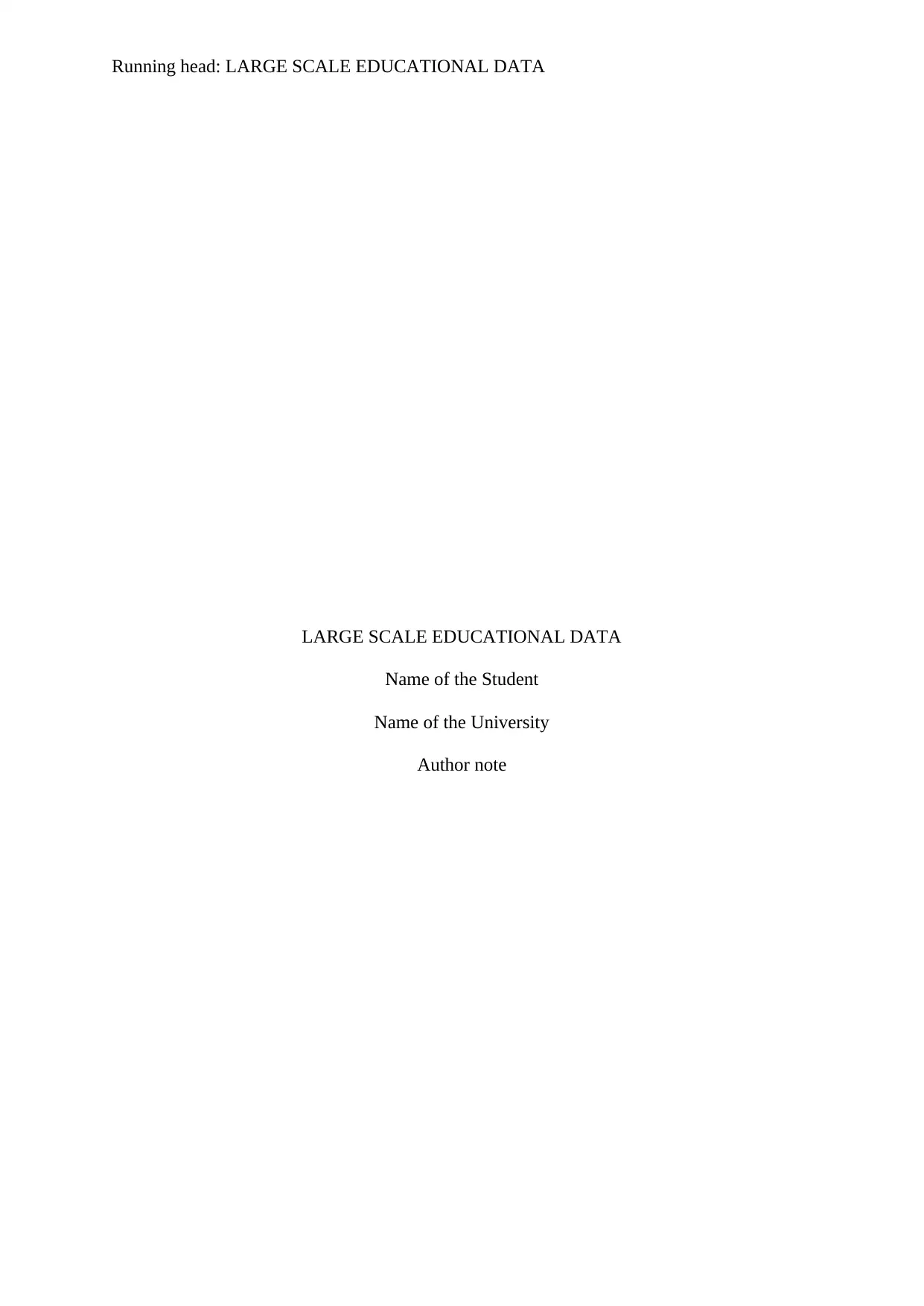
Running head: LARGE SCALE EDUCATIONAL DATA
LARGE SCALE EDUCATIONAL DATA
Name of the Student
Name of the University
Author note
LARGE SCALE EDUCATIONAL DATA
Name of the Student
Name of the University
Author note
Paraphrase This Document
Need a fresh take? Get an instant paraphrase of this document with our AI Paraphraser
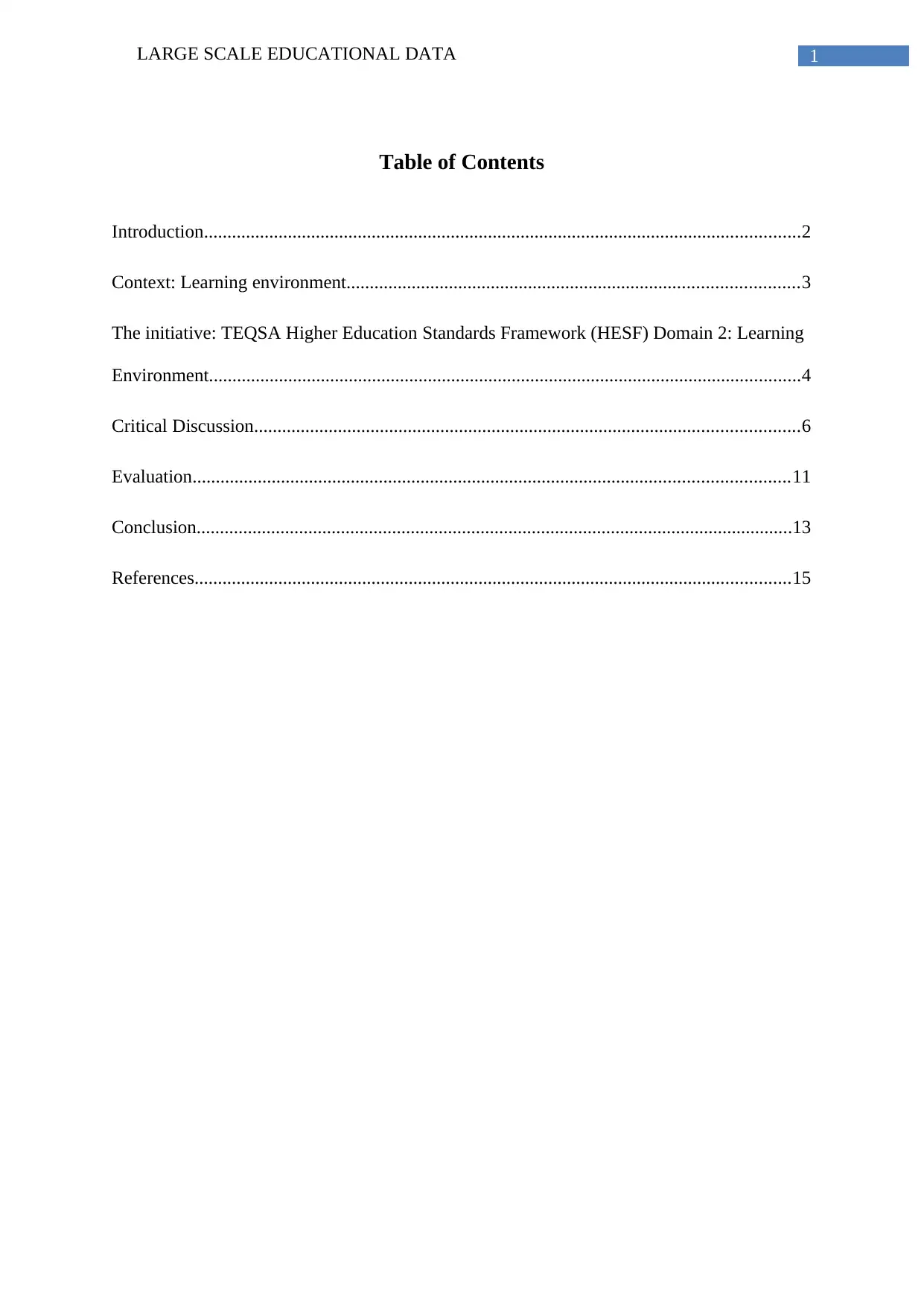
1LARGE SCALE EDUCATIONAL DATA
Table of Contents
Introduction................................................................................................................................2
Context: Learning environment.................................................................................................3
The initiative: TEQSA Higher Education Standards Framework (HESF) Domain 2: Learning
Environment...............................................................................................................................4
Critical Discussion.....................................................................................................................6
Evaluation................................................................................................................................11
Conclusion................................................................................................................................13
References................................................................................................................................15
Table of Contents
Introduction................................................................................................................................2
Context: Learning environment.................................................................................................3
The initiative: TEQSA Higher Education Standards Framework (HESF) Domain 2: Learning
Environment...............................................................................................................................4
Critical Discussion.....................................................................................................................6
Evaluation................................................................................................................................11
Conclusion................................................................................................................................13
References................................................................................................................................15
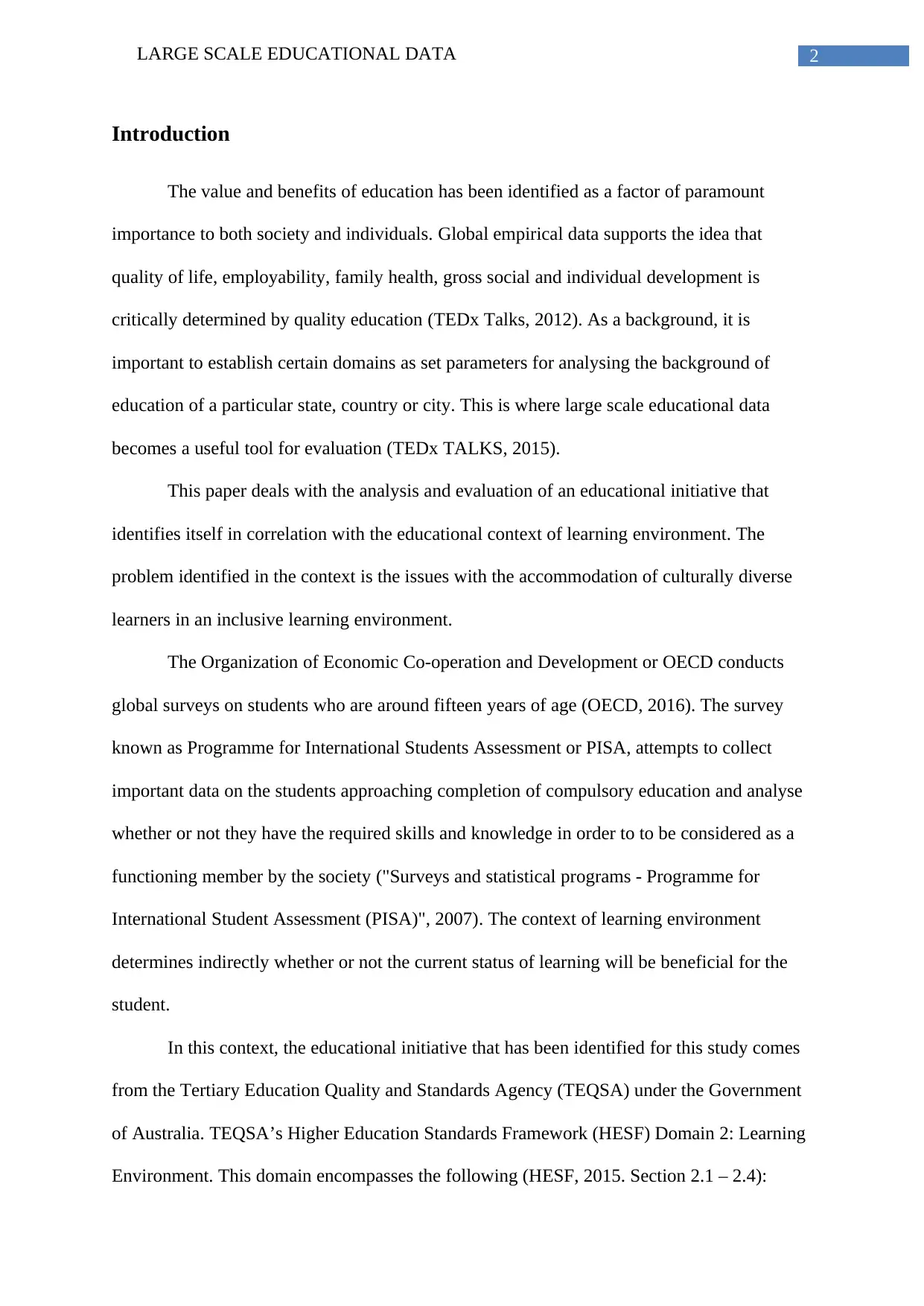
2LARGE SCALE EDUCATIONAL DATA
Introduction
The value and benefits of education has been identified as a factor of paramount
importance to both society and individuals. Global empirical data supports the idea that
quality of life, employability, family health, gross social and individual development is
critically determined by quality education (TEDx Talks, 2012). As a background, it is
important to establish certain domains as set parameters for analysing the background of
education of a particular state, country or city. This is where large scale educational data
becomes a useful tool for evaluation (TEDx TALKS, 2015).
This paper deals with the analysis and evaluation of an educational initiative that
identifies itself in correlation with the educational context of learning environment. The
problem identified in the context is the issues with the accommodation of culturally diverse
learners in an inclusive learning environment.
The Organization of Economic Co-operation and Development or OECD conducts
global surveys on students who are around fifteen years of age (OECD, 2016). The survey
known as Programme for International Students Assessment or PISA, attempts to collect
important data on the students approaching completion of compulsory education and analyse
whether or not they have the required skills and knowledge in order to to be considered as a
functioning member by the society ("Surveys and statistical programs - Programme for
International Student Assessment (PISA)", 2007). The context of learning environment
determines indirectly whether or not the current status of learning will be beneficial for the
student.
In this context, the educational initiative that has been identified for this study comes
from the Tertiary Education Quality and Standards Agency (TEQSA) under the Government
of Australia. TEQSA’s Higher Education Standards Framework (HESF) Domain 2: Learning
Environment. This domain encompasses the following (HESF, 2015. Section 2.1 – 2.4):
Introduction
The value and benefits of education has been identified as a factor of paramount
importance to both society and individuals. Global empirical data supports the idea that
quality of life, employability, family health, gross social and individual development is
critically determined by quality education (TEDx Talks, 2012). As a background, it is
important to establish certain domains as set parameters for analysing the background of
education of a particular state, country or city. This is where large scale educational data
becomes a useful tool for evaluation (TEDx TALKS, 2015).
This paper deals with the analysis and evaluation of an educational initiative that
identifies itself in correlation with the educational context of learning environment. The
problem identified in the context is the issues with the accommodation of culturally diverse
learners in an inclusive learning environment.
The Organization of Economic Co-operation and Development or OECD conducts
global surveys on students who are around fifteen years of age (OECD, 2016). The survey
known as Programme for International Students Assessment or PISA, attempts to collect
important data on the students approaching completion of compulsory education and analyse
whether or not they have the required skills and knowledge in order to to be considered as a
functioning member by the society ("Surveys and statistical programs - Programme for
International Student Assessment (PISA)", 2007). The context of learning environment
determines indirectly whether or not the current status of learning will be beneficial for the
student.
In this context, the educational initiative that has been identified for this study comes
from the Tertiary Education Quality and Standards Agency (TEQSA) under the Government
of Australia. TEQSA’s Higher Education Standards Framework (HESF) Domain 2: Learning
Environment. This domain encompasses the following (HESF, 2015. Section 2.1 – 2.4):
⊘ This is a preview!⊘
Do you want full access?
Subscribe today to unlock all pages.

Trusted by 1+ million students worldwide
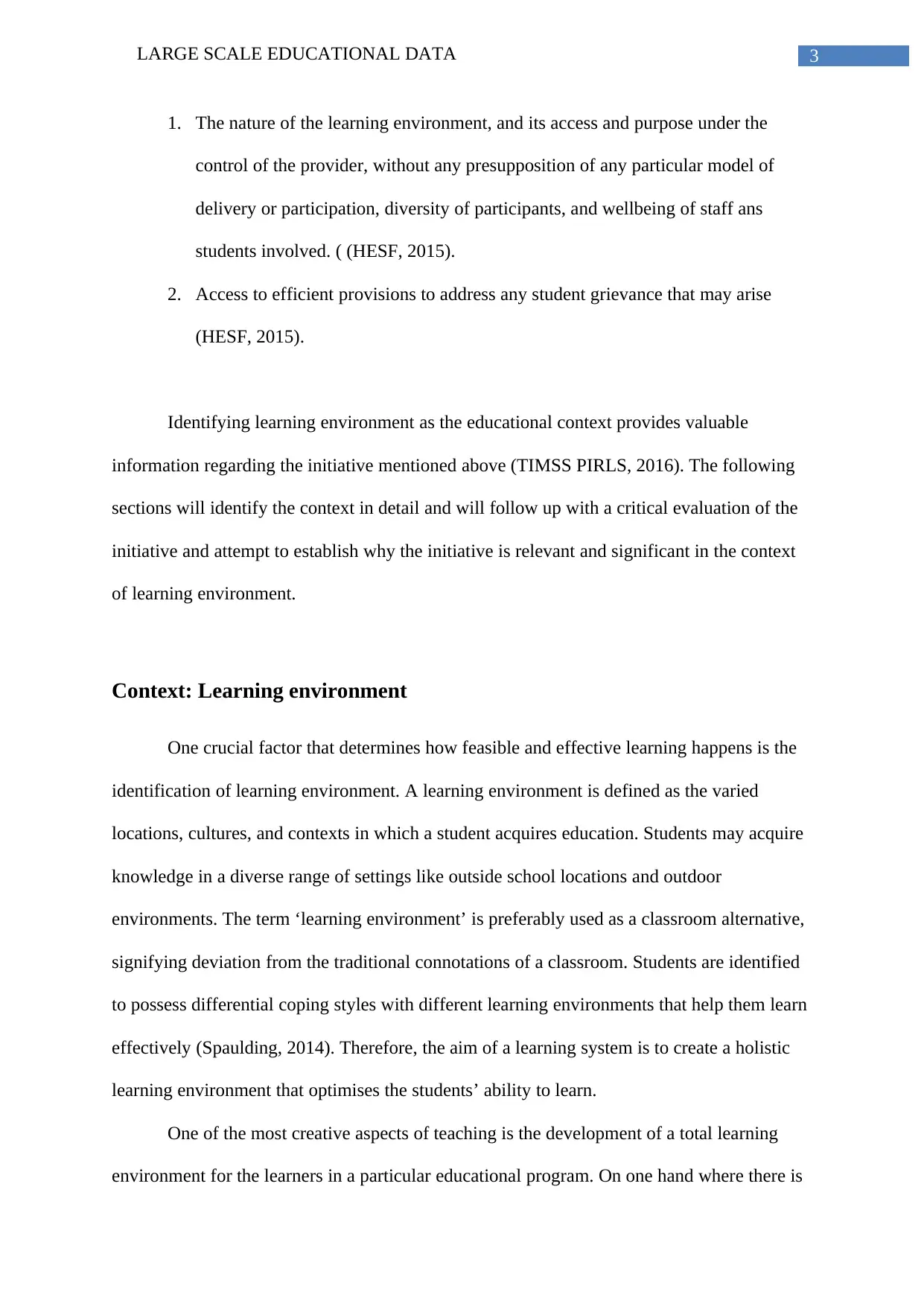
3LARGE SCALE EDUCATIONAL DATA
1. The nature of the learning environment, and its access and purpose under the
control of the provider, without any presupposition of any particular model of
delivery or participation, diversity of participants, and wellbeing of staff ans
students involved. ( (HESF, 2015).
2. Access to efficient provisions to address any student grievance that may arise
(HESF, 2015).
Identifying learning environment as the educational context provides valuable
information regarding the initiative mentioned above (TIMSS PIRLS, 2016). The following
sections will identify the context in detail and will follow up with a critical evaluation of the
initiative and attempt to establish why the initiative is relevant and significant in the context
of learning environment.
Context: Learning environment
One crucial factor that determines how feasible and effective learning happens is the
identification of learning environment. A learning environment is defined as the varied
locations, cultures, and contexts in which a student acquires education. Students may acquire
knowledge in a diverse range of settings like outside school locations and outdoor
environments. The term ‘learning environment’ is preferably used as a classroom alternative,
signifying deviation from the traditional connotations of a classroom. Students are identified
to possess differential coping styles with different learning environments that help them learn
effectively (Spaulding, 2014). Therefore, the aim of a learning system is to create a holistic
learning environment that optimises the students’ ability to learn.
One of the most creative aspects of teaching is the development of a total learning
environment for the learners in a particular educational program. On one hand where there is
1. The nature of the learning environment, and its access and purpose under the
control of the provider, without any presupposition of any particular model of
delivery or participation, diversity of participants, and wellbeing of staff ans
students involved. ( (HESF, 2015).
2. Access to efficient provisions to address any student grievance that may arise
(HESF, 2015).
Identifying learning environment as the educational context provides valuable
information regarding the initiative mentioned above (TIMSS PIRLS, 2016). The following
sections will identify the context in detail and will follow up with a critical evaluation of the
initiative and attempt to establish why the initiative is relevant and significant in the context
of learning environment.
Context: Learning environment
One crucial factor that determines how feasible and effective learning happens is the
identification of learning environment. A learning environment is defined as the varied
locations, cultures, and contexts in which a student acquires education. Students may acquire
knowledge in a diverse range of settings like outside school locations and outdoor
environments. The term ‘learning environment’ is preferably used as a classroom alternative,
signifying deviation from the traditional connotations of a classroom. Students are identified
to possess differential coping styles with different learning environments that help them learn
effectively (Spaulding, 2014). Therefore, the aim of a learning system is to create a holistic
learning environment that optimises the students’ ability to learn.
One of the most creative aspects of teaching is the development of a total learning
environment for the learners in a particular educational program. On one hand where there is
Paraphrase This Document
Need a fresh take? Get an instant paraphrase of this document with our AI Paraphraser
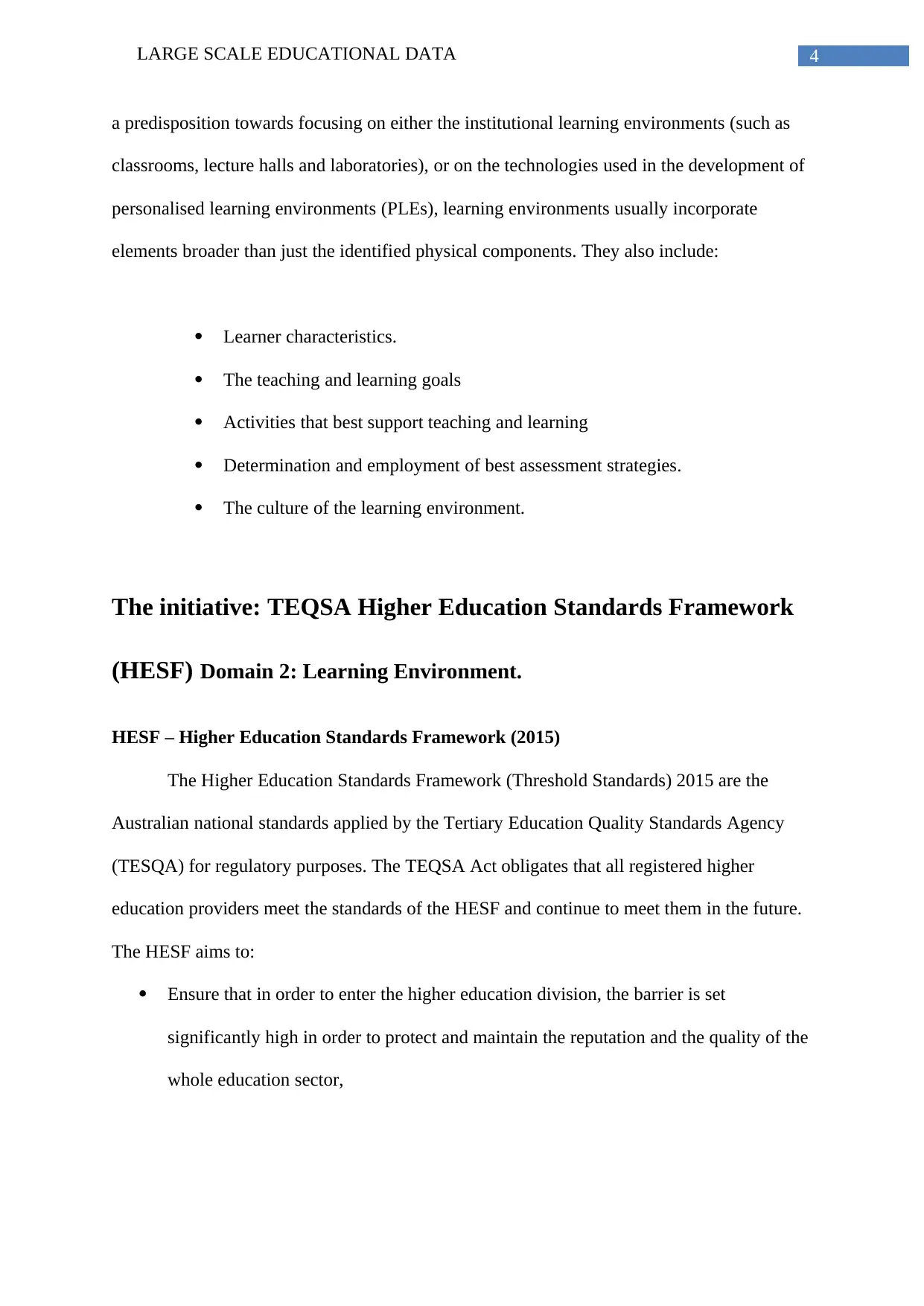
4LARGE SCALE EDUCATIONAL DATA
a predisposition towards focusing on either the institutional learning environments (such as
classrooms, lecture halls and laboratories), or on the technologies used in the development of
personalised learning environments (PLEs), learning environments usually incorporate
elements broader than just the identified physical components. They also include:
Learner characteristics.
The teaching and learning goals
Activities that best support teaching and learning
Determination and employment of best assessment strategies.
The culture of the learning environment.
The initiative: TEQSA Higher Education Standards Framework
(HESF) Domain 2: Learning Environment.
HESF – Higher Education Standards Framework (2015)
The Higher Education Standards Framework (Threshold Standards) 2015 are the
Australian national standards applied by the Tertiary Education Quality Standards Agency
(TESQA) for regulatory purposes. The TEQSA Act obligates that all registered higher
education providers meet the standards of the HESF and continue to meet them in the future.
The HESF aims to:
Ensure that in order to enter the higher education division, the barrier is set
significantly high in order to protect and maintain the reputation and the quality of the
whole education sector,
a predisposition towards focusing on either the institutional learning environments (such as
classrooms, lecture halls and laboratories), or on the technologies used in the development of
personalised learning environments (PLEs), learning environments usually incorporate
elements broader than just the identified physical components. They also include:
Learner characteristics.
The teaching and learning goals
Activities that best support teaching and learning
Determination and employment of best assessment strategies.
The culture of the learning environment.
The initiative: TEQSA Higher Education Standards Framework
(HESF) Domain 2: Learning Environment.
HESF – Higher Education Standards Framework (2015)
The Higher Education Standards Framework (Threshold Standards) 2015 are the
Australian national standards applied by the Tertiary Education Quality Standards Agency
(TESQA) for regulatory purposes. The TEQSA Act obligates that all registered higher
education providers meet the standards of the HESF and continue to meet them in the future.
The HESF aims to:
Ensure that in order to enter the higher education division, the barrier is set
significantly high in order to protect and maintain the reputation and the quality of the
whole education sector,
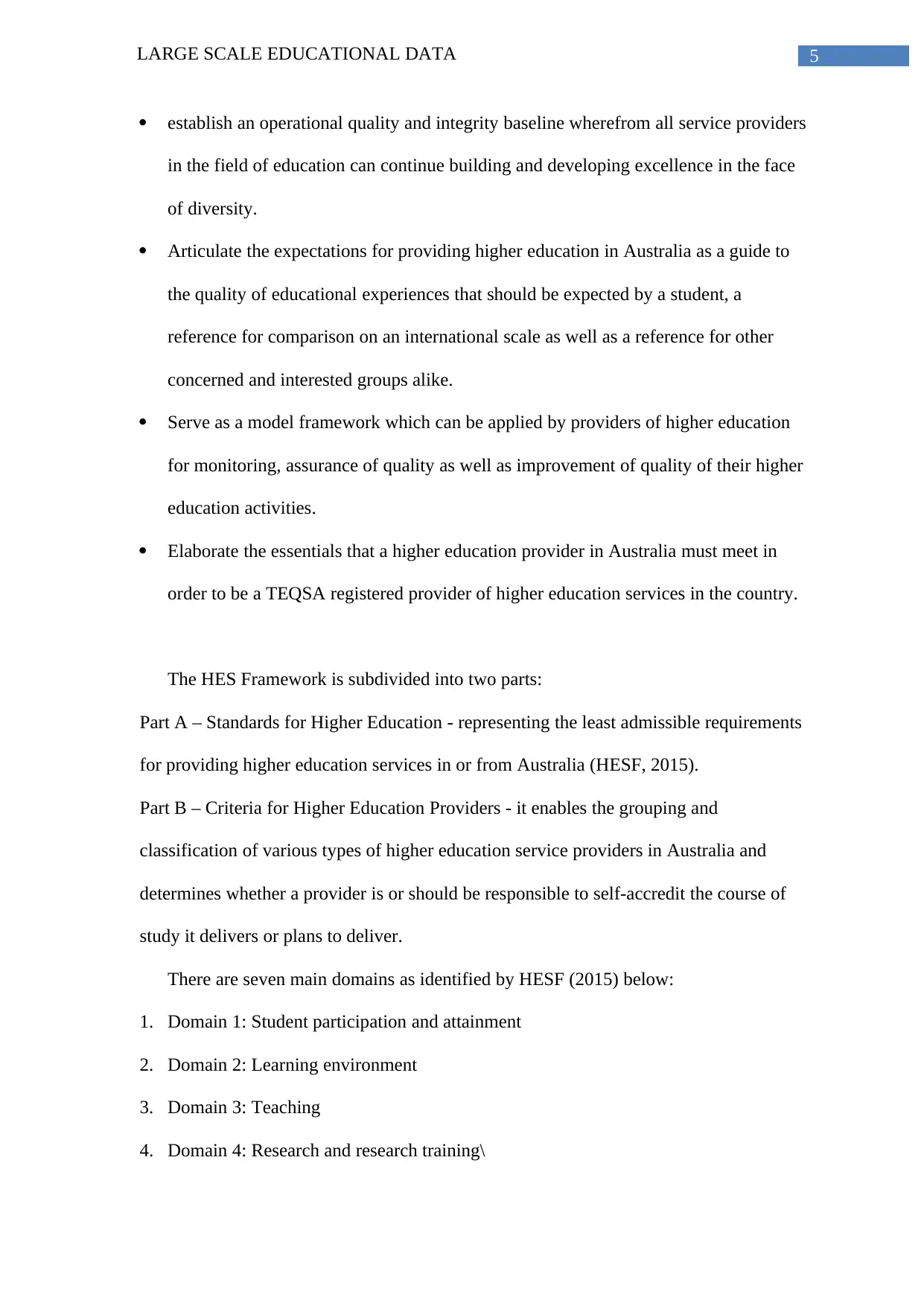
5LARGE SCALE EDUCATIONAL DATA
establish an operational quality and integrity baseline wherefrom all service providers
in the field of education can continue building and developing excellence in the face
of diversity.
Articulate the expectations for providing higher education in Australia as a guide to
the quality of educational experiences that should be expected by a student, a
reference for comparison on an international scale as well as a reference for other
concerned and interested groups alike.
Serve as a model framework which can be applied by providers of higher education
for monitoring, assurance of quality as well as improvement of quality of their higher
education activities.
Elaborate the essentials that a higher education provider in Australia must meet in
order to be a TEQSA registered provider of higher education services in the country.
The HES Framework is subdivided into two parts:
Part A – Standards for Higher Education - representing the least admissible requirements
for providing higher education services in or from Australia (HESF, 2015).
Part B – Criteria for Higher Education Providers - it enables the grouping and
classification of various types of higher education service providers in Australia and
determines whether a provider is or should be responsible to self-accredit the course of
study it delivers or plans to deliver.
There are seven main domains as identified by HESF (2015) below:
1. Domain 1: Student participation and attainment
2. Domain 2: Learning environment
3. Domain 3: Teaching
4. Domain 4: Research and research training\
establish an operational quality and integrity baseline wherefrom all service providers
in the field of education can continue building and developing excellence in the face
of diversity.
Articulate the expectations for providing higher education in Australia as a guide to
the quality of educational experiences that should be expected by a student, a
reference for comparison on an international scale as well as a reference for other
concerned and interested groups alike.
Serve as a model framework which can be applied by providers of higher education
for monitoring, assurance of quality as well as improvement of quality of their higher
education activities.
Elaborate the essentials that a higher education provider in Australia must meet in
order to be a TEQSA registered provider of higher education services in the country.
The HES Framework is subdivided into two parts:
Part A – Standards for Higher Education - representing the least admissible requirements
for providing higher education services in or from Australia (HESF, 2015).
Part B – Criteria for Higher Education Providers - it enables the grouping and
classification of various types of higher education service providers in Australia and
determines whether a provider is or should be responsible to self-accredit the course of
study it delivers or plans to deliver.
There are seven main domains as identified by HESF (2015) below:
1. Domain 1: Student participation and attainment
2. Domain 2: Learning environment
3. Domain 3: Teaching
4. Domain 4: Research and research training\
⊘ This is a preview!⊘
Do you want full access?
Subscribe today to unlock all pages.

Trusted by 1+ million students worldwide
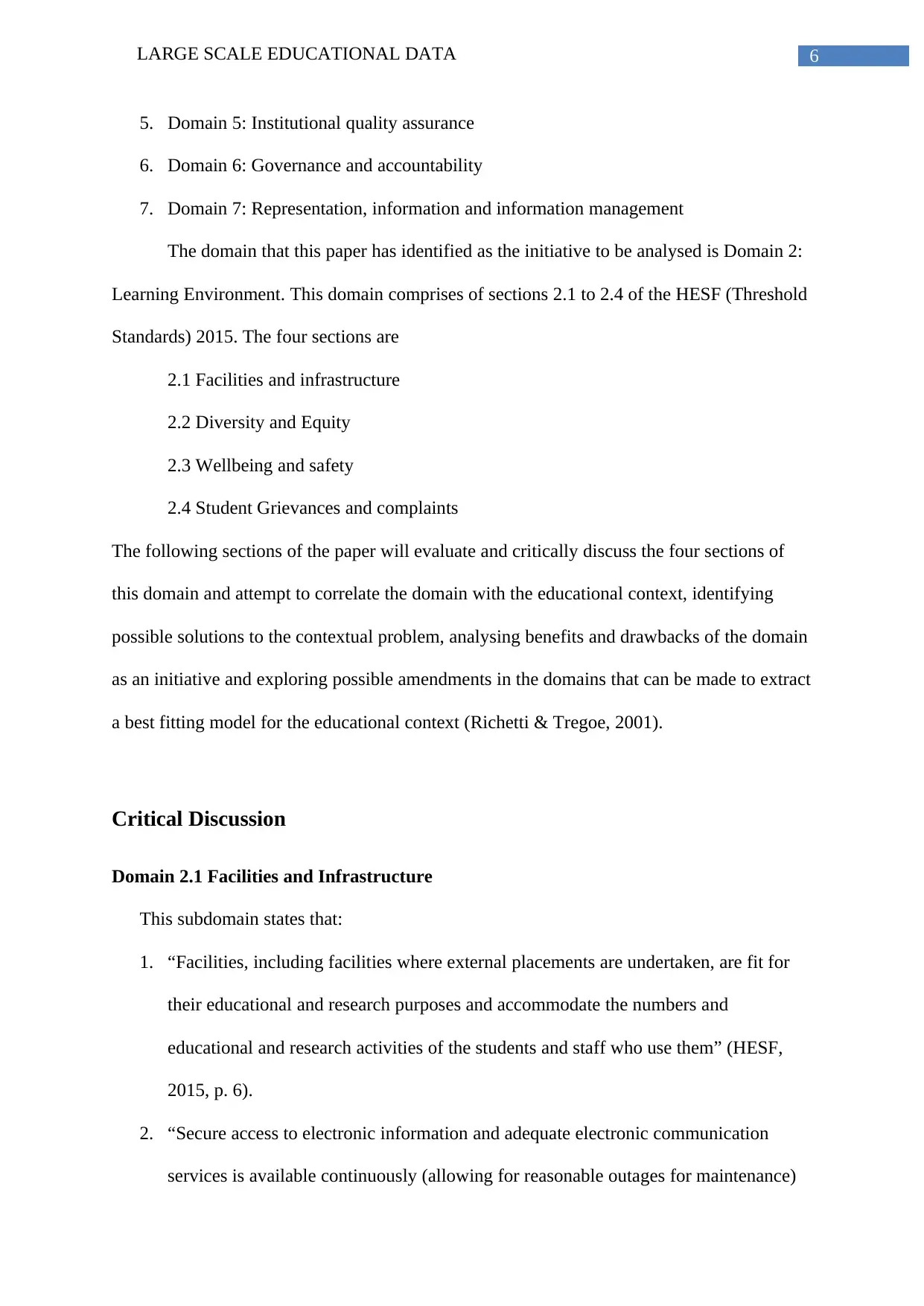
6LARGE SCALE EDUCATIONAL DATA
5. Domain 5: Institutional quality assurance
6. Domain 6: Governance and accountability
7. Domain 7: Representation, information and information management
The domain that this paper has identified as the initiative to be analysed is Domain 2:
Learning Environment. This domain comprises of sections 2.1 to 2.4 of the HESF (Threshold
Standards) 2015. The four sections are
2.1 Facilities and infrastructure
2.2 Diversity and Equity
2.3 Wellbeing and safety
2.4 Student Grievances and complaints
The following sections of the paper will evaluate and critically discuss the four sections of
this domain and attempt to correlate the domain with the educational context, identifying
possible solutions to the contextual problem, analysing benefits and drawbacks of the domain
as an initiative and exploring possible amendments in the domains that can be made to extract
a best fitting model for the educational context (Richetti & Tregoe, 2001).
Critical Discussion
Domain 2.1 Facilities and Infrastructure
This subdomain states that:
1. “Facilities, including facilities where external placements are undertaken, are fit for
their educational and research purposes and accommodate the numbers and
educational and research activities of the students and staff who use them” (HESF,
2015, p. 6).
2. “Secure access to electronic information and adequate electronic communication
services is available continuously (allowing for reasonable outages for maintenance)
5. Domain 5: Institutional quality assurance
6. Domain 6: Governance and accountability
7. Domain 7: Representation, information and information management
The domain that this paper has identified as the initiative to be analysed is Domain 2:
Learning Environment. This domain comprises of sections 2.1 to 2.4 of the HESF (Threshold
Standards) 2015. The four sections are
2.1 Facilities and infrastructure
2.2 Diversity and Equity
2.3 Wellbeing and safety
2.4 Student Grievances and complaints
The following sections of the paper will evaluate and critically discuss the four sections of
this domain and attempt to correlate the domain with the educational context, identifying
possible solutions to the contextual problem, analysing benefits and drawbacks of the domain
as an initiative and exploring possible amendments in the domains that can be made to extract
a best fitting model for the educational context (Richetti & Tregoe, 2001).
Critical Discussion
Domain 2.1 Facilities and Infrastructure
This subdomain states that:
1. “Facilities, including facilities where external placements are undertaken, are fit for
their educational and research purposes and accommodate the numbers and
educational and research activities of the students and staff who use them” (HESF,
2015, p. 6).
2. “Secure access to electronic information and adequate electronic communication
services is available continuously (allowing for reasonable outages for maintenance)
Paraphrase This Document
Need a fresh take? Get an instant paraphrase of this document with our AI Paraphraser
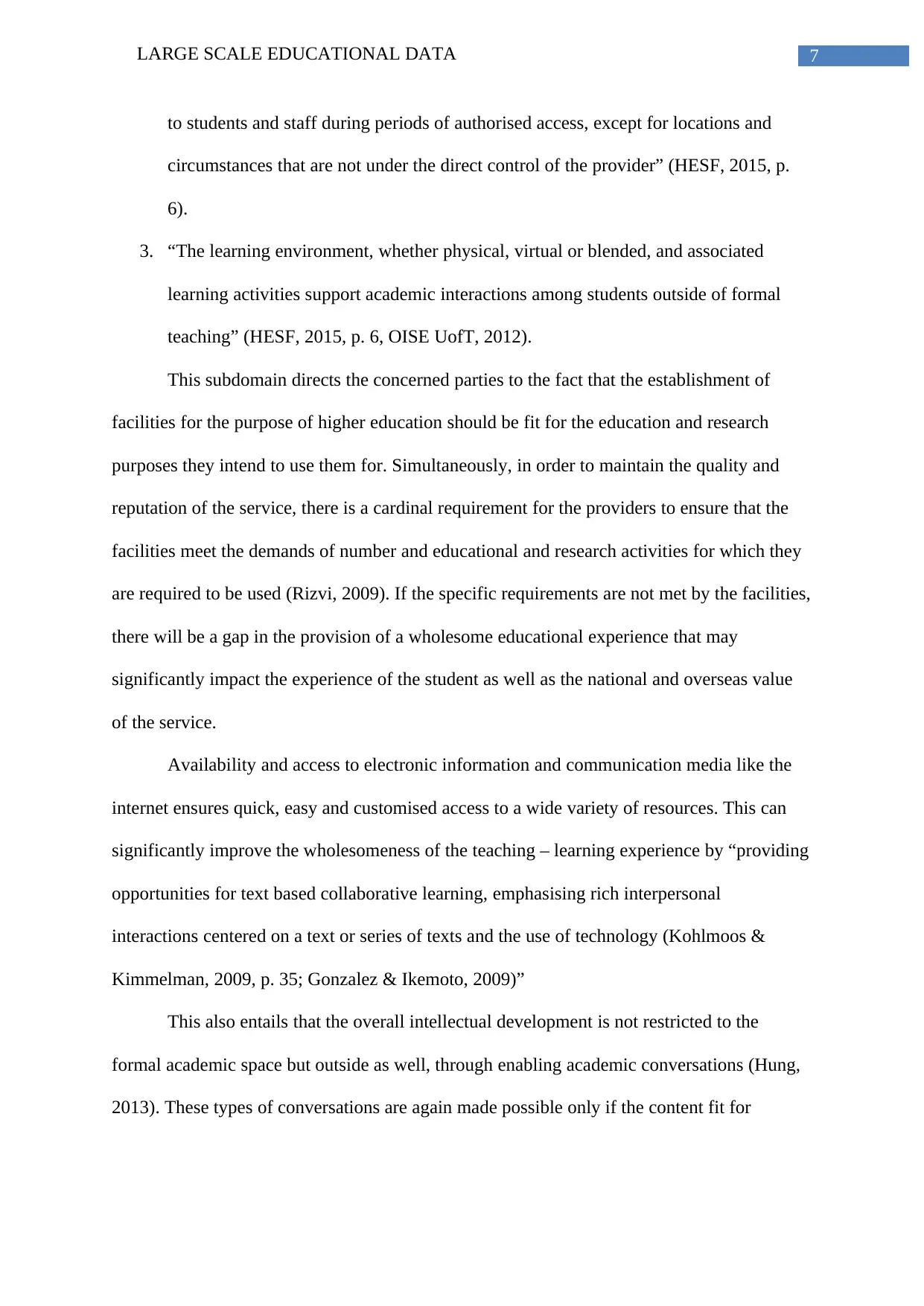
7LARGE SCALE EDUCATIONAL DATA
to students and staff during periods of authorised access, except for locations and
circumstances that are not under the direct control of the provider” (HESF, 2015, p.
6).
3. “The learning environment, whether physical, virtual or blended, and associated
learning activities support academic interactions among students outside of formal
teaching” (HESF, 2015, p. 6, OISE UofT, 2012).
This subdomain directs the concerned parties to the fact that the establishment of
facilities for the purpose of higher education should be fit for the education and research
purposes they intend to use them for. Simultaneously, in order to maintain the quality and
reputation of the service, there is a cardinal requirement for the providers to ensure that the
facilities meet the demands of number and educational and research activities for which they
are required to be used (Rizvi, 2009). If the specific requirements are not met by the facilities,
there will be a gap in the provision of a wholesome educational experience that may
significantly impact the experience of the student as well as the national and overseas value
of the service.
Availability and access to electronic information and communication media like the
internet ensures quick, easy and customised access to a wide variety of resources. This can
significantly improve the wholesomeness of the teaching – learning experience by “providing
opportunities for text based collaborative learning, emphasising rich interpersonal
interactions centered on a text or series of texts and the use of technology (Kohlmoos &
Kimmelman, 2009, p. 35; Gonzalez & Ikemoto, 2009)”
This also entails that the overall intellectual development is not restricted to the
formal academic space but outside as well, through enabling academic conversations (Hung,
2013). These types of conversations are again made possible only if the content fit for
to students and staff during periods of authorised access, except for locations and
circumstances that are not under the direct control of the provider” (HESF, 2015, p.
6).
3. “The learning environment, whether physical, virtual or blended, and associated
learning activities support academic interactions among students outside of formal
teaching” (HESF, 2015, p. 6, OISE UofT, 2012).
This subdomain directs the concerned parties to the fact that the establishment of
facilities for the purpose of higher education should be fit for the education and research
purposes they intend to use them for. Simultaneously, in order to maintain the quality and
reputation of the service, there is a cardinal requirement for the providers to ensure that the
facilities meet the demands of number and educational and research activities for which they
are required to be used (Rizvi, 2009). If the specific requirements are not met by the facilities,
there will be a gap in the provision of a wholesome educational experience that may
significantly impact the experience of the student as well as the national and overseas value
of the service.
Availability and access to electronic information and communication media like the
internet ensures quick, easy and customised access to a wide variety of resources. This can
significantly improve the wholesomeness of the teaching – learning experience by “providing
opportunities for text based collaborative learning, emphasising rich interpersonal
interactions centered on a text or series of texts and the use of technology (Kohlmoos &
Kimmelman, 2009, p. 35; Gonzalez & Ikemoto, 2009)”
This also entails that the overall intellectual development is not restricted to the
formal academic space but outside as well, through enabling academic conversations (Hung,
2013). These types of conversations are again made possible only if the content fit for
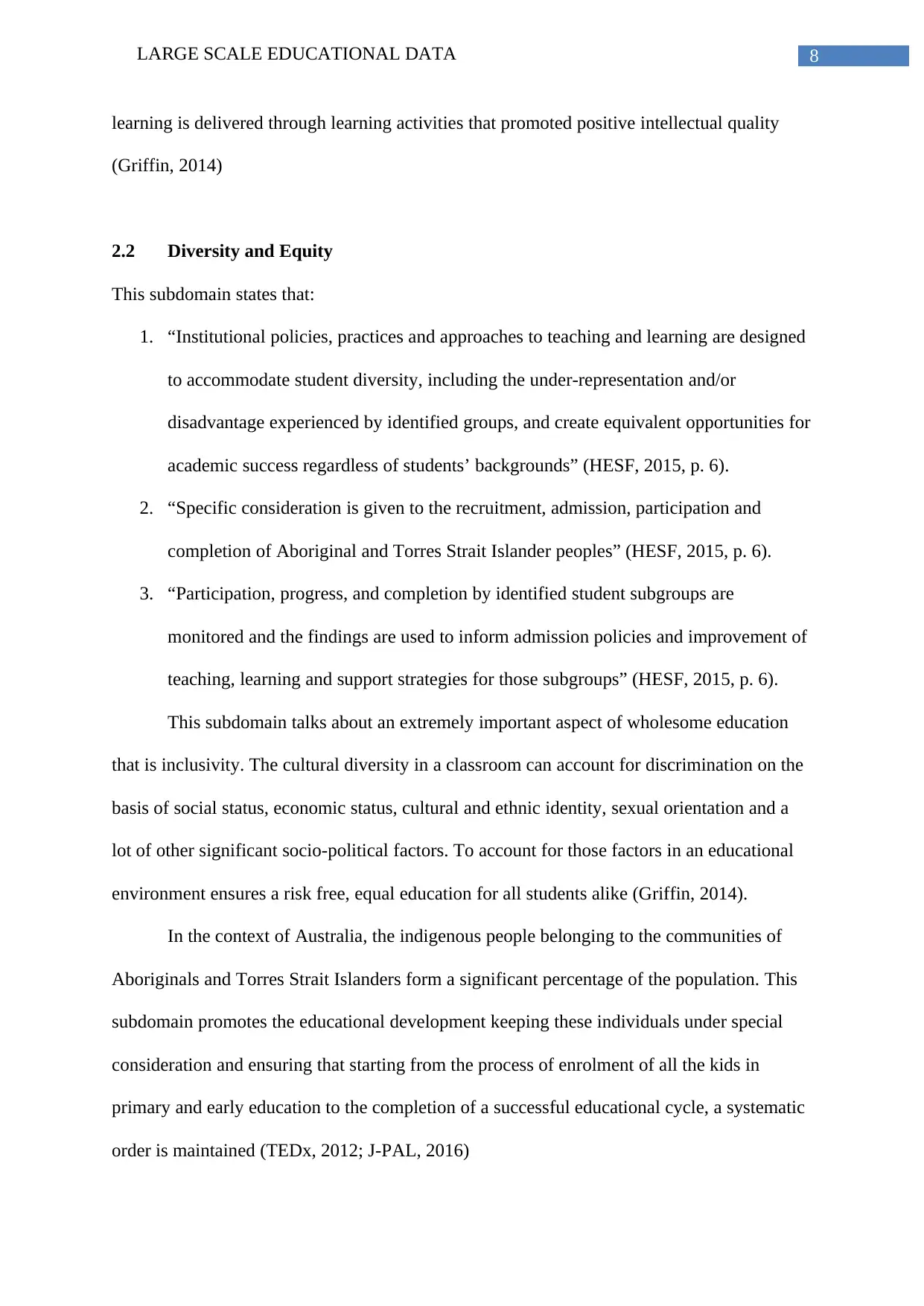
8LARGE SCALE EDUCATIONAL DATA
learning is delivered through learning activities that promoted positive intellectual quality
(Griffin, 2014)
2.2 Diversity and Equity
This subdomain states that:
1. “Institutional policies, practices and approaches to teaching and learning are designed
to accommodate student diversity, including the under-representation and/or
disadvantage experienced by identified groups, and create equivalent opportunities for
academic success regardless of students’ backgrounds” (HESF, 2015, p. 6).
2. “Specific consideration is given to the recruitment, admission, participation and
completion of Aboriginal and Torres Strait Islander peoples” (HESF, 2015, p. 6).
3. “Participation, progress, and completion by identified student subgroups are
monitored and the findings are used to inform admission policies and improvement of
teaching, learning and support strategies for those subgroups” (HESF, 2015, p. 6).
This subdomain talks about an extremely important aspect of wholesome education
that is inclusivity. The cultural diversity in a classroom can account for discrimination on the
basis of social status, economic status, cultural and ethnic identity, sexual orientation and a
lot of other significant socio-political factors. To account for those factors in an educational
environment ensures a risk free, equal education for all students alike (Griffin, 2014).
In the context of Australia, the indigenous people belonging to the communities of
Aboriginals and Torres Strait Islanders form a significant percentage of the population. This
subdomain promotes the educational development keeping these individuals under special
consideration and ensuring that starting from the process of enrolment of all the kids in
primary and early education to the completion of a successful educational cycle, a systematic
order is maintained (TEDx, 2012; J-PAL, 2016)
learning is delivered through learning activities that promoted positive intellectual quality
(Griffin, 2014)
2.2 Diversity and Equity
This subdomain states that:
1. “Institutional policies, practices and approaches to teaching and learning are designed
to accommodate student diversity, including the under-representation and/or
disadvantage experienced by identified groups, and create equivalent opportunities for
academic success regardless of students’ backgrounds” (HESF, 2015, p. 6).
2. “Specific consideration is given to the recruitment, admission, participation and
completion of Aboriginal and Torres Strait Islander peoples” (HESF, 2015, p. 6).
3. “Participation, progress, and completion by identified student subgroups are
monitored and the findings are used to inform admission policies and improvement of
teaching, learning and support strategies for those subgroups” (HESF, 2015, p. 6).
This subdomain talks about an extremely important aspect of wholesome education
that is inclusivity. The cultural diversity in a classroom can account for discrimination on the
basis of social status, economic status, cultural and ethnic identity, sexual orientation and a
lot of other significant socio-political factors. To account for those factors in an educational
environment ensures a risk free, equal education for all students alike (Griffin, 2014).
In the context of Australia, the indigenous people belonging to the communities of
Aboriginals and Torres Strait Islanders form a significant percentage of the population. This
subdomain promotes the educational development keeping these individuals under special
consideration and ensuring that starting from the process of enrolment of all the kids in
primary and early education to the completion of a successful educational cycle, a systematic
order is maintained (TEDx, 2012; J-PAL, 2016)
⊘ This is a preview!⊘
Do you want full access?
Subscribe today to unlock all pages.

Trusted by 1+ million students worldwide
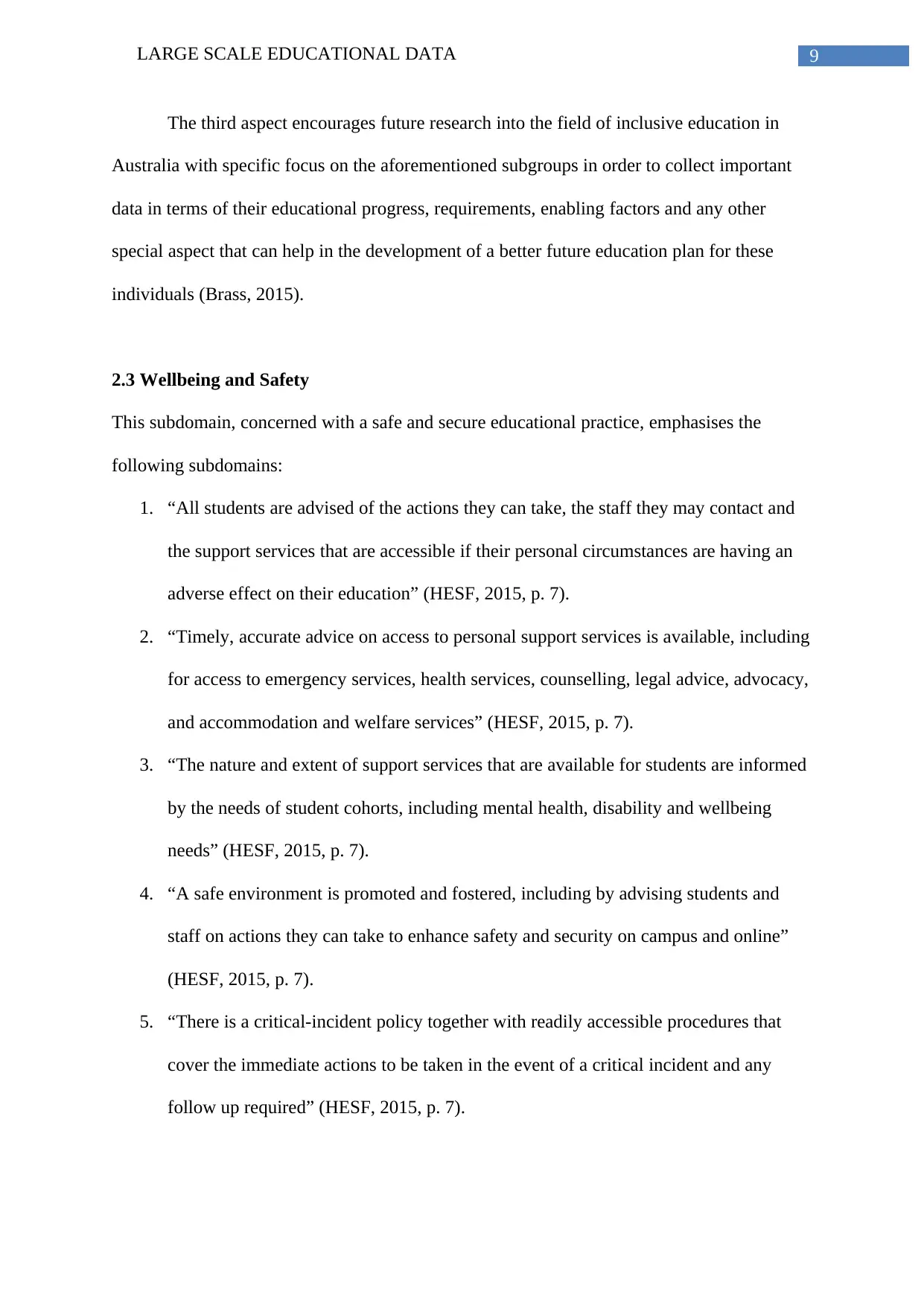
9LARGE SCALE EDUCATIONAL DATA
The third aspect encourages future research into the field of inclusive education in
Australia with specific focus on the aforementioned subgroups in order to collect important
data in terms of their educational progress, requirements, enabling factors and any other
special aspect that can help in the development of a better future education plan for these
individuals (Brass, 2015).
2.3 Wellbeing and Safety
This subdomain, concerned with a safe and secure educational practice, emphasises the
following subdomains:
1. “All students are advised of the actions they can take, the staff they may contact and
the support services that are accessible if their personal circumstances are having an
adverse effect on their education” (HESF, 2015, p. 7).
2. “Timely, accurate advice on access to personal support services is available, including
for access to emergency services, health services, counselling, legal advice, advocacy,
and accommodation and welfare services” (HESF, 2015, p. 7).
3. “The nature and extent of support services that are available for students are informed
by the needs of student cohorts, including mental health, disability and wellbeing
needs” (HESF, 2015, p. 7).
4. “A safe environment is promoted and fostered, including by advising students and
staff on actions they can take to enhance safety and security on campus and online”
(HESF, 2015, p. 7).
5. “There is a critical-incident policy together with readily accessible procedures that
cover the immediate actions to be taken in the event of a critical incident and any
follow up required” (HESF, 2015, p. 7).
The third aspect encourages future research into the field of inclusive education in
Australia with specific focus on the aforementioned subgroups in order to collect important
data in terms of their educational progress, requirements, enabling factors and any other
special aspect that can help in the development of a better future education plan for these
individuals (Brass, 2015).
2.3 Wellbeing and Safety
This subdomain, concerned with a safe and secure educational practice, emphasises the
following subdomains:
1. “All students are advised of the actions they can take, the staff they may contact and
the support services that are accessible if their personal circumstances are having an
adverse effect on their education” (HESF, 2015, p. 7).
2. “Timely, accurate advice on access to personal support services is available, including
for access to emergency services, health services, counselling, legal advice, advocacy,
and accommodation and welfare services” (HESF, 2015, p. 7).
3. “The nature and extent of support services that are available for students are informed
by the needs of student cohorts, including mental health, disability and wellbeing
needs” (HESF, 2015, p. 7).
4. “A safe environment is promoted and fostered, including by advising students and
staff on actions they can take to enhance safety and security on campus and online”
(HESF, 2015, p. 7).
5. “There is a critical-incident policy together with readily accessible procedures that
cover the immediate actions to be taken in the event of a critical incident and any
follow up required” (HESF, 2015, p. 7).
Paraphrase This Document
Need a fresh take? Get an instant paraphrase of this document with our AI Paraphraser
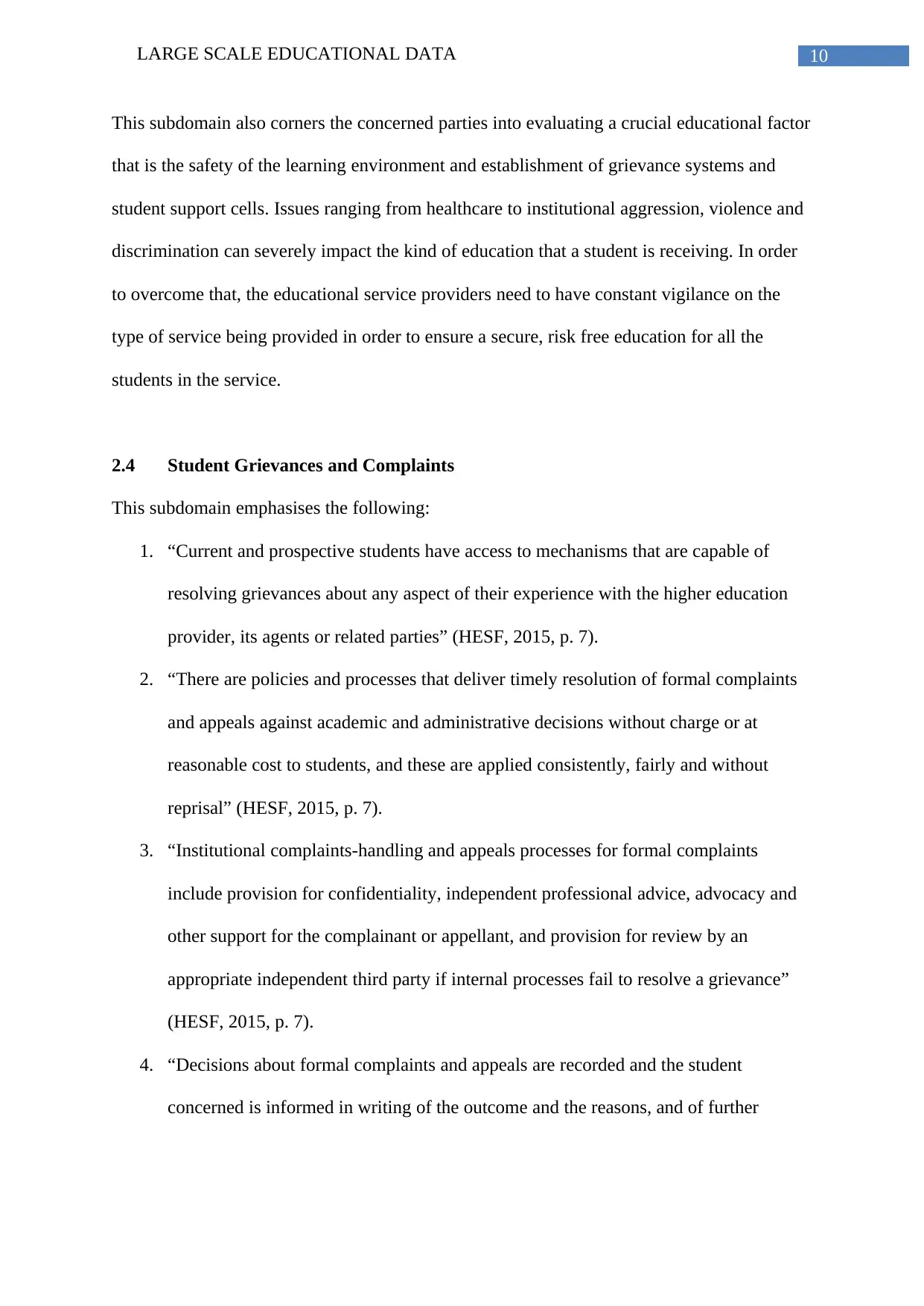
10LARGE SCALE EDUCATIONAL DATA
This subdomain also corners the concerned parties into evaluating a crucial educational factor
that is the safety of the learning environment and establishment of grievance systems and
student support cells. Issues ranging from healthcare to institutional aggression, violence and
discrimination can severely impact the kind of education that a student is receiving. In order
to overcome that, the educational service providers need to have constant vigilance on the
type of service being provided in order to ensure a secure, risk free education for all the
students in the service.
2.4 Student Grievances and Complaints
This subdomain emphasises the following:
1. “Current and prospective students have access to mechanisms that are capable of
resolving grievances about any aspect of their experience with the higher education
provider, its agents or related parties” (HESF, 2015, p. 7).
2. “There are policies and processes that deliver timely resolution of formal complaints
and appeals against academic and administrative decisions without charge or at
reasonable cost to students, and these are applied consistently, fairly and without
reprisal” (HESF, 2015, p. 7).
3. “Institutional complaints-handling and appeals processes for formal complaints
include provision for confidentiality, independent professional advice, advocacy and
other support for the complainant or appellant, and provision for review by an
appropriate independent third party if internal processes fail to resolve a grievance”
(HESF, 2015, p. 7).
4. “Decisions about formal complaints and appeals are recorded and the student
concerned is informed in writing of the outcome and the reasons, and of further
This subdomain also corners the concerned parties into evaluating a crucial educational factor
that is the safety of the learning environment and establishment of grievance systems and
student support cells. Issues ranging from healthcare to institutional aggression, violence and
discrimination can severely impact the kind of education that a student is receiving. In order
to overcome that, the educational service providers need to have constant vigilance on the
type of service being provided in order to ensure a secure, risk free education for all the
students in the service.
2.4 Student Grievances and Complaints
This subdomain emphasises the following:
1. “Current and prospective students have access to mechanisms that are capable of
resolving grievances about any aspect of their experience with the higher education
provider, its agents or related parties” (HESF, 2015, p. 7).
2. “There are policies and processes that deliver timely resolution of formal complaints
and appeals against academic and administrative decisions without charge or at
reasonable cost to students, and these are applied consistently, fairly and without
reprisal” (HESF, 2015, p. 7).
3. “Institutional complaints-handling and appeals processes for formal complaints
include provision for confidentiality, independent professional advice, advocacy and
other support for the complainant or appellant, and provision for review by an
appropriate independent third party if internal processes fail to resolve a grievance”
(HESF, 2015, p. 7).
4. “Decisions about formal complaints and appeals are recorded and the student
concerned is informed in writing of the outcome and the reasons, and of further
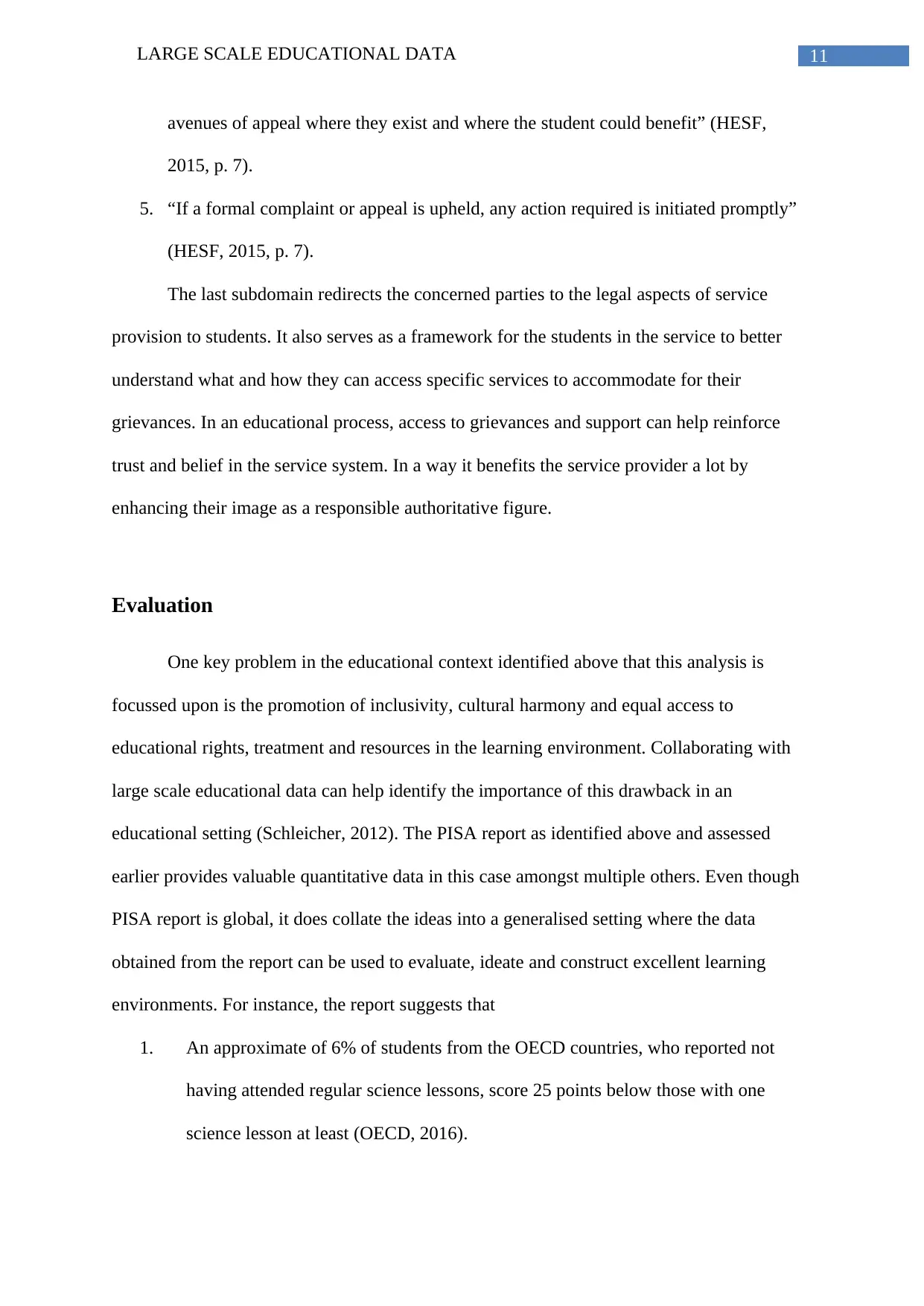
11LARGE SCALE EDUCATIONAL DATA
avenues of appeal where they exist and where the student could benefit” (HESF,
2015, p. 7).
5. “If a formal complaint or appeal is upheld, any action required is initiated promptly”
(HESF, 2015, p. 7).
The last subdomain redirects the concerned parties to the legal aspects of service
provision to students. It also serves as a framework for the students in the service to better
understand what and how they can access specific services to accommodate for their
grievances. In an educational process, access to grievances and support can help reinforce
trust and belief in the service system. In a way it benefits the service provider a lot by
enhancing their image as a responsible authoritative figure.
Evaluation
One key problem in the educational context identified above that this analysis is
focussed upon is the promotion of inclusivity, cultural harmony and equal access to
educational rights, treatment and resources in the learning environment. Collaborating with
large scale educational data can help identify the importance of this drawback in an
educational setting (Schleicher, 2012). The PISA report as identified above and assessed
earlier provides valuable quantitative data in this case amongst multiple others. Even though
PISA report is global, it does collate the ideas into a generalised setting where the data
obtained from the report can be used to evaluate, ideate and construct excellent learning
environments. For instance, the report suggests that
1. An approximate of 6% of students from the OECD countries, who reported not
having attended regular science lessons, score 25 points below those with one
science lesson at least (OECD, 2016).
avenues of appeal where they exist and where the student could benefit” (HESF,
2015, p. 7).
5. “If a formal complaint or appeal is upheld, any action required is initiated promptly”
(HESF, 2015, p. 7).
The last subdomain redirects the concerned parties to the legal aspects of service
provision to students. It also serves as a framework for the students in the service to better
understand what and how they can access specific services to accommodate for their
grievances. In an educational process, access to grievances and support can help reinforce
trust and belief in the service system. In a way it benefits the service provider a lot by
enhancing their image as a responsible authoritative figure.
Evaluation
One key problem in the educational context identified above that this analysis is
focussed upon is the promotion of inclusivity, cultural harmony and equal access to
educational rights, treatment and resources in the learning environment. Collaborating with
large scale educational data can help identify the importance of this drawback in an
educational setting (Schleicher, 2012). The PISA report as identified above and assessed
earlier provides valuable quantitative data in this case amongst multiple others. Even though
PISA report is global, it does collate the ideas into a generalised setting where the data
obtained from the report can be used to evaluate, ideate and construct excellent learning
environments. For instance, the report suggests that
1. An approximate of 6% of students from the OECD countries, who reported not
having attended regular science lessons, score 25 points below those with one
science lesson at least (OECD, 2016).
⊘ This is a preview!⊘
Do you want full access?
Subscribe today to unlock all pages.

Trusted by 1+ million students worldwide
1 out of 19
Related Documents
Your All-in-One AI-Powered Toolkit for Academic Success.
+13062052269
info@desklib.com
Available 24*7 on WhatsApp / Email
![[object Object]](/_next/static/media/star-bottom.7253800d.svg)
Unlock your academic potential
Copyright © 2020–2025 A2Z Services. All Rights Reserved. Developed and managed by ZUCOL.





